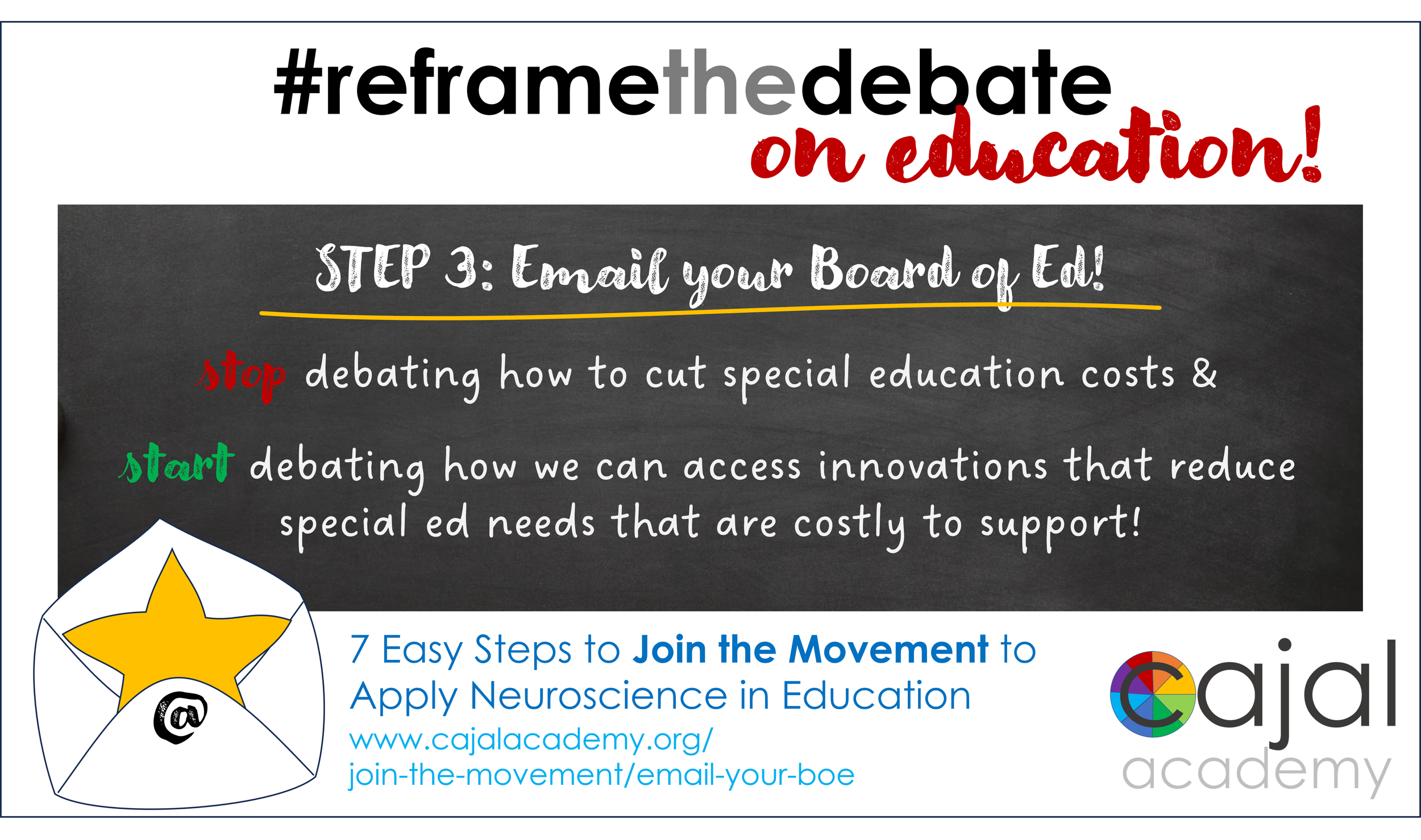Tell your district about innovation they can access under existing law today that reduces long-term costs, while contributing to research that can catapult your district forward in the future!
Email your School Board, Superintendent or Special Education Director
Time Commitment: 5 minutes
What You're Asking For:
✅ Explore partnership with innovative programs under 10-76g
✅ Consider how Cajal's approach could inform district programs
✅ Give Connecticut families access to proven innovation
You're NOT:
❌ Criticizing the district
❌ Demanding they fund Cajal, or support its program for a particular child
❌ Attacking traditional special education
Why This Matters:
Connecticut school boards are debating how to cut special education costs—often by avoiding outplacements and creating in-house programs.
But they may not know:
Connecticut has homegrown innovation: a first-of-its-kind program that reduces or even removes learning and in some cases social-emotional and executive function disabilities through a research-backed methodology: something previously not thought possible
Because they remove disabilities rather than just accommodate them, this reduces educational costs for the remaining K-12 years by as much as $100,000 in specialists time and therapeutic placements avoided.
Existing CT law (10-76g) permits partnerships with programs that reduce costs relative to the publicly-available arrangement—even without state approval—with the same cost reimbursement mechanisms
It’s part of Cajal’s non-profit charter to publish and disseminate these break-throughs.
Facilitating a student’s outplacement to Cajal today captures savings for this student—and adds to a research cohort that can give our district access to innovations that could inform our own in-house programs.
Your email helps them see a third option: Not just cut vs. don't cut, but innovate.
Here’s how to do this in just 5 minutes!
Click on the ‘plus’ sign beside each title to get the details!
-
Subject: Request to Explore Innovation Under CT 10-76g
Dear [School Board Members / Superintendent [Name]],
I'm writing as a [parent/taxpayer/community member] to request that our district explore partnership opportunities with innovative programs that reduce special education costs under existing Connecticut law.
The Challenge We Face:
Our district, like many in Connecticut, is working to reduce special education costs. I understand the pressure you're under with tight budgets, rising costs and the uncertainty over federal funding and changing policy.
An Opportunity You May Not Know About:
Connecticut has homegrown innovation: a small non-profit in the heart of South Norwalk’s historic district has developed a research-backed methodology that’s proving successful at reducing or even removing learning and in some cases social-emotional and executive function disabilities—not just accommodate them—by applying the science of neuroplasticity to rewire how the child approaches the challenged tasks.
Results: Since 2019, this has led to remarkable results, including as much as a 6 grade level jump in 6 months time across both reading and writing; transformational social-emotional outcomes preventing therapeutic escalations with results reported at home in as little as a few weeks. Students can transition to back to the mainstream environment with reduced special education needs or even no IEP at all, in as little as 1-2 years in the program,or stay through graduation for college-ready skill-building curriculum
Cost Savings: Because their approach changes the fundamentals of the child’s learning and social-emotional profile itself, this could reduce their educational costs for the remaining K-12 years by as much as $100,000 in specialists time and therapeutic placements avoided—in fact, they actually reduce the child’s tuition as they make progress through the various stages of their neurodevelopmental approach. Today the program has proven results with twice exceptional learners; in the future they will begin testing their protocols with other student cohorts as well.
Legal and Accreditation: Existing CT law (10-76g) permits partnerships with programs that reduce costs relative to the publicly-available arrangement—even without state approval—and allows districts to apply the same cost reimbursements as are the case for state-approved programs. Cajal has received Candidacy for Accreditation from the New England Association of Schools and Colleges (NEASC).
Research Access: It’s part of Cajal’s non-profit charter to publish and disseminate these break-throughs. Facilitating a student’s outplacement to Cajal today captures savings for this student—and adds to a research cohort that can give our district access to innovations that could inform our own in-house programs.
My Request:
I'm not asking for immediate decisions—just openness to exploring what's possible:
Meet with Cajal Academy leadership to review their documented outcomes
Understand their approach to preventing therapeutic placement escalation
Explore partnership possibilities under existing 10-76g authority
Consider how their research could inform our district's programs
Why Now:
Connecticut families need access to innovation that works. Our district needs cost-effective solutions. Cajal has both proven outcomes and a mission to share findings with public schools.
This isn't about criticism—it's about partnership. You're working hard with the tools you have. I'm simply sharing information about tools that may not be on your radar yet.
Would the board be willing to have an exploratory conversation?
I'd be happy to facilitate an introduction to Cajal's leadership for an informational presentation—no strings attached.
Thank you for your service to our students and community.
Respectfully,
[Your Name] [Your Address] [Your Phone/Email]
P.S. Cajal Academy is expanding their research cohort specifically to create publication-quality evidence that districts can use. Early partner districts gain access to findings through professional development opportunities. More information at www.cajalacademy.org/for-school-districts.
-
Make it yours by adding:
Local context: "With our district's recent [budget cuts/challenges], this seems worth exploring..."
Personal connection: "As a parent of a [2e child/student with learning differences], I know how hard it is to find what works..."
Specific examples: "I've heard from [X families] in our district who wish they had access to approaches like this..."
Community angle: "Our town's special ed costs have increased [X%] in recent years..."
Keep it:
Respectful (they're doing their best)
Solution-focused (here's an opportunity)
Specific (10-76g, Cajal's outcomes)
Brief (they're busy)
-
Find your contacts:
School board members: [Usually on district website under "Board of Education"]
Superintendent: [District website under "Administration"]
Special education director: [Ask district office]
Send to all three for maximum impact.
-
We're tracking how many districts are hearing about this—helps us understand movement momentum and how to support families who live in each of our local communities.
If your board responds positively, this will also help us to facilitate the conversation.
-
Best case: Board/superintendent responds with interest, schedules meeting
Likely case: Forwarded to special ed director, may or may not respond
Worst case: No response (they're overwhelmed—doesn't mean no impact)
Follow-up: If no response in 2 weeks, consider:
Attending school board meeting to speak during public comment
Asking to be added to upcoming agenda
Connecting with board member individually
-
Q: Will this make the district think I'm criticizing them? A: The template is carefully worded to be constructive and partnership-oriented. You're sharing information, not attacking.
Q: What if my district says they can't afford it? A: The 10-76g point is that it reduces costs over time. Year 1 may be comparable, but prevents $150K-$250K/year therapeutic placements.
Q: What if they say it's not state-approved? A: That's exactly why you're mentioning 10-76g—state approval isn't required when programs reduce costs.
Q: I don't have a child in special ed. Should I still write? A: Yes! As a taxpayer, you have standing to ask about cost-effective approaches.
Q: What if other parents want to write too? A: Great! Multiple voices = stronger message. But personalize—don't send identical emails.
Done! What’s next?
Thank You! Here are some more quick and easy actions you can take to support our movement to #ReframeTheDebate on Education!








